1994 Brazilian general election
The 1994 Brazilian presidential election was held on October 3, 1994. It was the second to take place under the provisions of the 1988 Constitution and only the second direct presidential election since 1960.
| ||||||||||||||||||||||||||||||||||||||||||||||||||||||||||||||||||||||||||||||||||||||||||||||||
|
| ||||||||||||||||||||||||||||||||||||||||||||||||||||||||||||||||||||||||||||||||||||||||||||||||
Presidential election | ||||||||||||||||||||||||||||||||||||||||||||||||||||||||||||||||||||||||||||||||||||||||||||||||
| Turnout | 82.23% | |||||||||||||||||||||||||||||||||||||||||||||||||||||||||||||||||||||||||||||||||||||||||||||||
|---|---|---|---|---|---|---|---|---|---|---|---|---|---|---|---|---|---|---|---|---|---|---|---|---|---|---|---|---|---|---|---|---|---|---|---|---|---|---|---|---|---|---|---|---|---|---|---|---|---|---|---|---|---|---|---|---|---|---|---|---|---|---|---|---|---|---|---|---|---|---|---|---|---|---|---|---|---|---|---|---|---|---|---|---|---|---|---|---|---|---|---|---|---|---|---|---|
| ||||||||||||||||||||||||||||||||||||||||||||||||||||||||||||||||||||||||||||||||||||||||||||||||
.svg.png.webp) Presidential election results map after voting: Blue denotes states won by Cardoso Red denotes states won by Lula | ||||||||||||||||||||||||||||||||||||||||||||||||||||||||||||||||||||||||||||||||||||||||||||||||
| ||||||||||||||||||||||||||||||||||||||||||||||||||||||||||||||||||||||||||||||||||||||||||||||||
Legislative election | ||||||||||||||||||||||||||||||||||||||||||||||||||||||||||||||||||||||||||||||||||||||||||||||||
513 seats in the Chamber of Deputies 257 seats needed for a majority | ||||||||||||||||||||||||||||||||||||||||||||||||||||||||||||||||||||||||||||||||||||||||||||||||
This lists parties that won seats. See the complete results below. | ||||||||||||||||||||||||||||||||||||||||||||||||||||||||||||||||||||||||||||||||||||||||||||||||
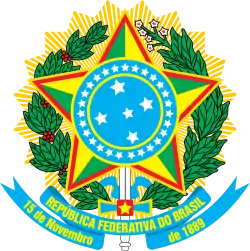 |
|---|
| This article is part of a series on the politics and government of Brazil |
|
|
Elected in 1989, Fernando Collor of the centre-right National Reconstruction Party (PRN) resigned in the face of an impeachment trial, resulting in Vice President Itamar Franco succeeding him.[1] Facing a fiscal crisis Franco's government launched the Plano Real ("Real Plan") to stabilize the national economy. The architect of the policy, Minister of Finance Fernando Henrique Cardoso,[2][3] was chosen by the PSDB to serve as their presidential candidate in Franco's absence. For the position of Vice President, Cardoso selected former presidential Chief of Staff Marco Maciel[4] of the Liberal Front Party (PFL).
Luiz Inácio Lula da Silva, a former labor leader and federal deputy for São Paulo who had narrowly lost the 1989 presidential election, resigned as president of the Workers' Party (PT) to mount a second presidential candidacy.[5] Lula intended to make José Paulo Bisol of the Brazilian Socialist Party (PSB) his running mate as he had in 1989.[6] However, Bisol was replaced by Lula ally and fellow PT member Aloizio Mercadante on the ticket.[7][8] In the spring of 1994, Lula appeared an overwhelming favorite over Cardoso, leading with 40% to Cardoso's 12% in an April poll and by a 41% to 17% margin as of May.[9] However, the Real Plan proved popular among Lula's own voters, with 70% of Lula supporters indicating their support for the Franco Administration's signature policy, and Lula was damaged by his opposition to the program.[9][10]
On election day, Cardoso won by a wide margin and absolute majority, negating the need for a second round. Cardoso notably won every state in the northeast, a region which would later emerge as the PT's political base.[11] The relative success of far-right candidate Enéas Carneiro, a cardiologist who had never won office before and ran as a member of the Party of the Reconstruction of the National (PRONA), was also noted; Carneiro won over 7% of the vote, placing him ahead of many established politicians.[12]
Background
In 1989, Brazil held its first direct presidential election since 1960 following the end of the military dictatorship in Brazil. Fernando Collor, a young, charismatic leader who had previous served as Governor of Alagoas, won a hotly contested election versus Luiz Inácio Lula da Silva after positioning himself as a political outsider.[13][14] Just over two years into his presidency, Collor was faced with allegations of corruption by his brother Pedro Collor, and chose to resign in late 1992 in the face of an impeachment trial.[15][16]
Following his resignation, Vice President Itamar Franco succeeded him in the office.[1] Once in office, Franco switched from the National Reconstruction Party (PRN) to the Brazilian Social Democracy Party (PSDB).[17] Facing a hyperinflation crisis and popular discontent, Franco's government pushed a fiscal policy known as the Plano Real (Real Plan) to stabilize the economy.[18] Minister of Finance Fernando Henrique Cardoso, an experienced politician who had previously served as Senator from São Paulo and as Franco's Minister of Foreign Affairs, served as the architect of the plan.[19]
Franco was barred from running for a full term in 1994. In Brazil, whenever a vice president serves part of a president's term, even when the president travels abroad, it counts as a full term. At the time, the Constitution did not allow a president to run for immediate reelection. In the absence of Franco, Cardoso would be chosen by the PSDB as their nominee for President of Brazil in the 1994 election.
Lula's running mate controversy
As he had in 1989, Lula intended for Senator José Paulo Bisol of Rio Grande do Sul, a member of the Brazilian Socialist Party (PSB), to serve as his vice presidential running mate. A former judge, Bisol had a strong reputation as an opponent of corruption,[20] playing a key role in the investigation that ultimately led to President Fernando Collor de Mello's resignation. Additionally, his membership of a party that played a crucial role in the centre-left coalition made his selection attractive to Lula.[21] However, Bisol's image as a "Mr. Clean" was harmed during campaign season by revelations of wrongdoing as a judge in 1981.[22]
The saga proved damaging to Lula's campaign, and as a result the leadership of the PT looked for a replacement for Bisol on the ticket. Arguing that Bisol should be replaced on the ticket by a fellow member of the PSB, PSB president Miguel Arraes pushed for the selection of Célio de Castro, then serving as Vice Mayor of Belo Horizonte, to replace Bisol as Lula's running mate.[23]
However, key power-players in the PT, such as party president Rui Falcão, successfully convinced Lula to replace Bisol with Aloízio Mercadante. A co-founder of the PT, Mercadante was then serving as a federal deputy for São Paulo.[24] Mercadante's background as a career economist during a hyperinflation crisis was seen as a plus for PT party leadership.[25]
Campaign of Enéas Carneiro
In the 1989 presidential election, the right-wing nationalist campaign of Enéas Carneiro received attention for Carneiro's exotic image. A short, bald man with a long beard and distinct "coke-bottle" glasses,[26] Carneiro's unusual appearance and signature catchphrase Meu nome é Enéas ("My name is Enéas") gained the cardiologist a following.[27] Nonetheless, Carneiro, who ran as a member of the Party of the Reconstruction of the National Order (PRONA), came 12th in a field of 21 candidates.
In 1994, Carneiro mounted a second bid for the presidency. The entrance of federal deputy Regina Gordilho of Rio de Janeiro, who had been elected as a member of the centre-left Democratic Labour Party, allowed his campaign to receive more guaranteed election time.[28] For the position of Vice President, Carneiro chose Rear Admiral[29] Roberto Gama e Silva to serve as his running mate.
Considered a nationalist and accused by opponents of being a member of the far-right,[30] Carneiro's unexpected third-place finish with over 7% of the national vote was considered a shocking result.[31] Carneiro, who had never been elected to office, received a larger share of the vote than longtime staple of the Brazilian Left Leonel Brizola, who had been a top candidate for the presidency four years prior.[32]
Candidates
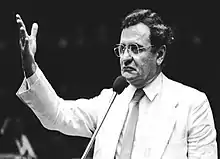
| # | Party/coalition | Presidential candidate | Political office(s) | Vice-Presidential candidate | |||
|---|---|---|---|---|---|---|---|
| 11 | 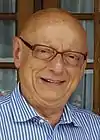 |
Esperidião Amin (PPR) | Senator for Santa Catarina 1991–98; Governor of Santa Catarina 1983–87; Mayor of Florianópolis 1975–79, 1989–90 | Gardênia Gonçalves (PPR) | |||
| 12 | PDT, PMN |
 |
Leonel Brizola (PDT) | Governor of Rio de Janeiro 1983–87, 1991–94; Federal Deputy from Guanabara 1963–64; Governor of Rio Grande do Sul 1959–63; Mayor of Porto Alegre 1956–58; Federal Deputy from Rio Grande do Sul 1955–56; State Deputy of Rio Grande do Sul 1947–55 |  |
Darcy Ribeiro (PDT) | |
| 13 | PT, PSB, PPS, PV, PCdoB, PCB, PSTU |
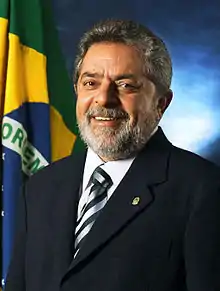 |
Luiz Inácio Lula da Silva (PT) | Federal Deputy from São Paulo 1987–91; PT National President 1980–88, 1990–94 | 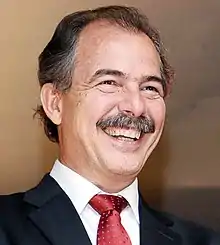 |
Aloizio Mercadante (PT) | |
| 15 | PMDB, PSD |
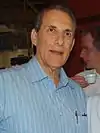 |
Orestes Quércia (PMDB) | Governor of São Paulo 1987–91; Vice Governor of São Paulo 1983–86; Senator for São Paulo 1975–83; Mayor of Campinas 1969–73; State Deputy of São Paulo 1967–69; City Councillor of Campinas 1963–66 |  |
Iris de Araújo (PMDB) | |
| 20 | Hernani Fortuna (PSC) | – | Vitor Nósseis (PSC) | ||||
| 36 | Carlos Antônio Gomes (PRN) | – | Dilton Carlos Salomoni (PRN) | ||||
| 45 | PSDB, PFL, PTB |
.jpg.webp) |
Fernando Henrique Cardoso (PSDB) | Minister of Finances 1993–94; Minister of Foreign Affairs 1992–93; Senator for São Paulo 1983–92 |  |
Marco Maciel (PFL) | |
| 56 |  |
Enéas Carneiro (PRONA) | PRONA National President 1989–2006 | Roberto Gama (PRONA) | |||
Candidacies denied
| # | Party/coalition | Presidential candidate | Political office(s) | Vice-Presidential candidate | |||
|---|---|---|---|---|---|---|---|
| 22 |  |
Flávio Rocha (PL) | Federal Deputy from Rio Grande do Norte 1987–95 | .jpg.webp) |
Marcos Cintra (PL) | ||
| 70 | Caetano Matanó Jr. (PTdoB) | – | Adolfo Lopes (PTdoB) | ||||
Results
President
| Candidate | Party | Running mate | Party | Votes | % | |
|---|---|---|---|---|---|---|
| Fernando Henrique Cardoso | PSDB | Marco Maciel | PFL | 34,314,961 | 54.24 | |
| Luiz Inácio Lula da Silva | PT | Aloizio Mercadante | PT | 17,122,127 | 27.07 | |
| Enéas Carneiro | PRONA | Roberto Gama | PRONA | 4,671,457 | 7.38 | |
| Orestes Quércia | PMDB | Iris de Araújo | PMDB | 2,772,121 | 4.38 | |
| Leonel Brizola | PDT | Darcy Ribeiro | PDT | 2,015,836 | 3.19 | |
| Esperidião Amin | PPR | Gardênia Gonçalves | PPR | 1,739,894 | 2.75 | |
| Carlos Antônio Gomes | PRN | Dilton Carlos Salomoni | PRN | 387,738 | 0.61 | |
| Hernani Fortuna | PSC | Vitor Nósseis | PSC | 238,197 | 0.38 | |
| Invalid/blank votes | 14,636,133 | − | ||||
| Total | 77,898,464 | 100 | ||||
| Registered voters/turnout | 94,732,410 | 82.23 | ||||
Chamber of Deputies

Notes
- Born in Rio de Janeiro, electoral based in São Paulo
- Born in Pernambuco, electoral based in São Paulo
- Born in Acre, electoral based in São Paulo
References
- "Itamar Franco, Former President of Brazil, Dies at 81 (Published 2011)". The New York Times. The Associated Press. 2011-07-04. ISSN 0362-4331. Retrieved 2020-12-02.
- Almanaque Abril, 28ª ed, 1995
- SAYAD, João. Observações sobre o Plano Real. Est. Econ. São Paulo. Vol. 25, Nº Especial, págs. 7-24, 1995-6
- "Brazil's new Embraer 70-seat jet rivals small Boeing, Airbus planes". Waterloo Region Record. 30 October 2001. p. C8. Retrieved 8 March 2011.
- "Lula's legacy for Brazil's next president". BBC News. 2010-09-30. Retrieved 2020-12-02.
- "Folha de S.Paulo - PT quer Mercadante para o lugar de Bisol - 27/7/1994". www1.folha.uol.com.br. Retrieved 2020-12-02.
- "Folha de S.Paulo - PT quer Mercadante para o lugar de Bisol - 27/7/1994". www1.folha.uol.com.br. Retrieved 2020-12-02.
- "'Depois da cadeia, Lula dificilmente voltará à política', diz vice da chapa do petista em 89 e 94". BBC News Brasil (in Portuguese). Retrieved 2020-12-02.
- "Eleição presidencial: o Plano Real na sucessão de Itamar Franco".
- Brooke, James (1994-09-14). "Taming of Inflation Buoys Centrist in Brazil Polls (Published 1994)". The New York Times. ISSN 0362-4331. Retrieved 2020-12-02.
- Lapper, Richard (2018-07-03). "It's Lula Forever in Brazil's Northeast". Americas Quarterly. Retrieved 2020-12-02.
- "O retorno de Enéas, ícone da extrema-direita e 'herói' de Bolsonaro". BBC News Brasil (in Portuguese). Retrieved 2020-12-02.
- "A guerra ao turbante". Abril. Veja.com. 23 March 1988. Retrieved 24 July 2012.
No seu papel de caçador de marajás, o alagoano Fernando Collor de Mello torna-se um dos governadores mais populares do país
- Brooke, James (1992-11-08). "Looting Brazil (Published 1992)". The New York Times. ISSN 0362-4331. Retrieved 2020-12-01.
- Rezende, Tatiana Matos. "UNE 70 Anos: "Fora Collor: o grito da juventude cara-pintada"". União Nacional dos Estudantes. Archived from the original on September 3, 2007. Retrieved August 9, 2009.
- Brooke, James (1994-12-20). "Pedro Collor, 43, the Brother And Nemesis of Brazil's Ex-Chief (Published 1994)". The New York Times. ISSN 0362-4331. Retrieved 2020-12-02.
- "President Itamar Franco - 1992-1994". www.globalsecurity.org. Retrieved 2020-12-02.
- "Itamar Franco, Former President of Brazil, Dies at 81 (Published 2011)". The New York Times. The Associated Press. 2011-07-04. ISSN 0362-4331. Retrieved 2020-12-02.
- "The echoes of 1994". The Economist. 2014-07-03. ISSN 0013-0613. Retrieved 2020-12-02.
- "Brazilian corruption commission under pressure". UPI. Retrieved 2020-12-02.
- "Folha de S.Paulo - Lula quer ter Bisol como vice na chapa - 30/4/1994". www1.folha.uol.com.br. Retrieved 2020-12-02.
- "POLITICS : Brazil's Leading Candidate Loses Momentum : Presidential hopeful Luiz Inacio Lula da Silva fights to avoid a runoff. His image is threatened by a scandal surrounding his choice of running mate". Los Angeles Times. 1994-07-15. Retrieved 2020-12-02.
- "Folha de S.Paulo - PT quer Mercadante para o lugar de Bisol - 27/7/1994". www1.folha.uol.com.br. Retrieved 2020-12-02.
- "Resist Newsletter, Sept. 1994 - Core" (PDF).
- "Folha de S.Paulo - PT quer Mercadante para o lugar de Bisol - 27/7/1994". www1.folha.uol.com.br. Retrieved 2020-12-02.
- Moffett, Matt (2006-06-20). "In Brazil, the Party Line Is Often Blurry". Wall Street Journal. ISSN 0099-9660. Retrieved 2020-12-02.
- ""Meu nome é Enéas": lenda da extrema-direita influenciou Bolsonaro, diz Le Monde". noticias.uol.com.br (in Portuguese). Retrieved 2020-12-02.
- "Folha de S.Paulo - Enéas não é Enéas - 30/9/1994". www1.folha.uol.com.br. Retrieved 2020-12-02.
- "Como preocupação com interesse estrangeiro levou militares a criar reserva extinta por Temer". BBC News Brasil (in Portuguese). Retrieved 2020-12-02.
- Wille, José. "O folclórico Enéas queria ser presidente em 1994 | Portal Memória Brasileira" (in Portuguese). Retrieved 2020-12-02.
- Rohter, Larry (2002-10-21). "Long Treated as a Joke, Brazilian Neofascist May Have the Last Laugh (Published 2002)". The New York Times. ISSN 0362-4331. Retrieved 2020-12-02.
- "Leonel Brizola, 82; Brazilian Politician". Los Angeles Times. 2004-06-23. Retrieved 2020-12-02.